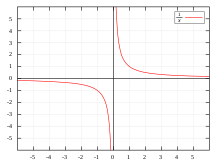Multiplicative inverse
The reciprocal (also the reciprocal value or reciprocal) of a number 




Properties
The closer a number is to 







The reciprocal of a fraction, that is, the reciprocal of a quotient 

From this follows the calculation rule for dividing by a fraction: Dividing by a fraction is done by multiplying by its reciprocal. See also fraction calculation.
The inverse 

Also, to every complex number 








The graph of the reciprocal function is a hyperbola.
Examples
- The reciprocal of
is again
.
- The reciprocal of
is
.
- The reciprocal of
is
.
- The reciprocal of the fraction
is
.
- The inverse of the complex number
is
.
Search within the encyclopedia


